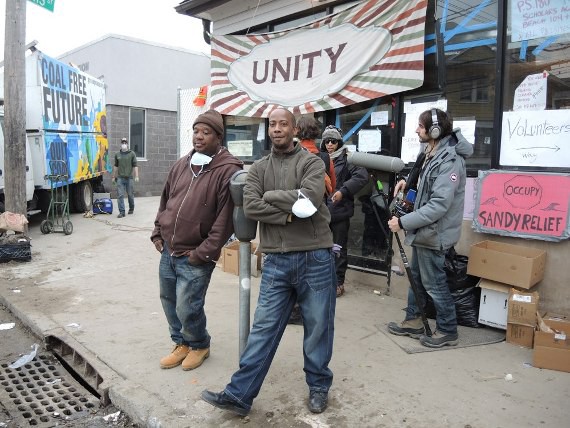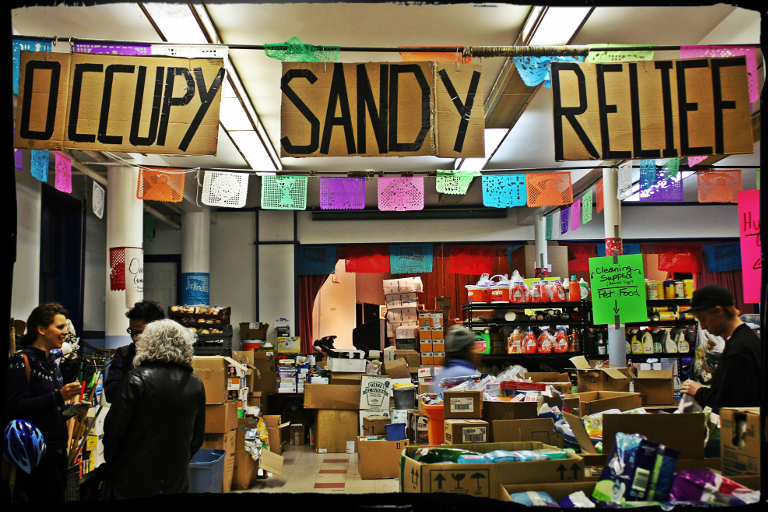This guest post for The World At 1°C remembers and explores Occupy Sandy as an exemplary community response to climate disasters. We hope this piece offers some practicality and hope as communities around the world recover from quakes, fires, and floods. The post was written by Lucas Burdick, a small-time freelance writer and professional volunteer. You can sign up here for monthly bulletins plus exclusive climate justice content direct to your inbox.
The Climate Crisis Requires Mutual Aid, Not Charity
If you want to rejuvenate your faith in frontline organizing, chase a hurricane and spend some weeks helping to rebuild homes and communities. Our newsfeeds, racing from travesty to travesty, spotlighting catastrophes and one-off heroism, can turn our attention away from hopeful stories of sustained, collective triumphs over ongoing crises. As Hurricane Harvey peters out, Irma wrecks Florida and leaves the Caribbean ravished, as Katia pumbles Mexico, as Jose looms, and as floods continue to ravage the Indian subcontinent, we may need stories that remind us that “disasters, in returning their sufferers to public and collective life,” diminish the privatization and isolation of our lives, as Rebecca Solnit wrote in A Paradise Built in Hell. The so many ecological catastrophes filling the air maybe make all the more vital lessons and histories of communities rising from debris.
Occupy Sandy was the fourth hurricane relief effort I witnessed first-hand; it impressed me more than the courageous, heart-filled community efforts I volunteered for after Katrina. As a week-long volunteer at Occupy Sandy, I spent a few days shadowing someone we’ll call Starling, Occupy’s coordinator for Red Hook, Starling’s Brooklyn Bay neighborhood, across the water from OWS’ Zuccotti Park.
Once, in the middle of her morning orientation for volunteers, Starling’s phone rang. “I have to take this, be right back,” she said to the sixty of us gathered outside a storage silo. When she returned minutes later, Starling announced, “That was the Red Cross. They wanted to know where Occupy Sandy has gone door-to-door, and where they should go. The Red Cross just called us, again, asking us what people need.” It had been six weeks since Sandy ravaged New York. Starling had been coordinating Occupy Sandy’s door-to-door support in Red Hook since the waters cleared. The training Starling was running when the Red Cross called was for volunteers going to check in on families and businesses.
That is the first lesson learned after any climate disaster: people and organizations there before the storm always become the first responders and last line of community support. Immediately after Sandy, charities “turned away potential volunteers in droves.” NGOs and state agencies often arrive late and take off too soon. Funds dry up as concern and media attention die down. Not based in any community, they do not face Day Zero. Concerned elsewhere long before Year One starts, the big names and agencies assist clean-up, but not resiliency. Giving to front-line-led organizations isn’t only the hip thing to do, but how to support efforts that matter most.

Photo Credit: WagingNonviolence.org
One often sung virtue of Occupy Sandy was the bounty of supplies collected and, literally, given away. The Red Cross only accepts cash donations, refusing household goods, which they claim “need to be cleaned, sorted, and repackaged, and all that takes up more time than they’re worth.” Household goods, food, and water are worth more than anything else after a crisis; many people need them across tundras of a disaster. As I saw in Red Hook, and as ProPublica later reported on in-depth, charity organizations did not begin assisting Sandy’s most impacted communities until weeks after the storm. The scope of what charity organizations provided NYC — shelters, caseworkers, meals, roving emergency vehicles — crucially helped thousands of people, but didn’t suffice, wasn’t always accessible, and wasn’t very responsive.
Occupy organized droves of volunteers, starting Week One, within areas most ravaged, by helping communities lead their own relief projects. “It’s crazy,” an Occupier in the Rockaways told reporters, “For a long time, we were the only people out here doing relief work.” But “we” were anyone who wanted to help. Volunteers from away worked side by side with locals who had lost everything. Businesses trucked in bottled water, cases of food. Occupy coordinated these diverse efforts largely by foregoing bureaucratic structures and instead delegating authority and responsibility, drawing on people power, not paid staff (a second lesson). Communities not only managed their own supplies and services but also provided spaces — school gyms, warehouses, churches — where Occupy setup pop-up distributions centers. Scattered across NY and NJ, supply centers were almost as orderly as supermarkets. Every item was inspected and sorted. Aisles were stocked with clothes, food, bottled water, baby supplies, hygiene products, medical supplies, furniture, batteries. And everything was for free.
Occupy Sandy provided another basic need often unmet after climate disasters: housing. Alongside this resurgence of Occupy, other networks of free association — Craigslist, Airbnb, CouchSurfers — became instant focal points of free support. While shelters provided large public spaces, households allowed people greater privacy and stability. Also, individual houses, apartments, and flats were not only housing but the homes of people from diverse communities. They were also homes near where people lived, worked, and went to school. Decentralized networks more easily branch out to meet localized needs, a third lesson learned.
Care for people with physical and mental disabilities, needs often undervalued by society, and sometimes overlooked by movements, was not ignored by Occupy Sandy. If organizers did not plan for caring for people with those additional needs, responding to them may have also come through localizing services, working with a range of volunteers, and sending volunteers door-to-door. Truth Out reported on how Occupy volunteers in the Rockaways heard by word of mouth of a seven-story apartment building with no power, heating, or water where many elderly people had stayed to ride out Sandy, subsisting for days on what they had at home. Neither FEMA nor the NY Housing Authority had ventured out to help. When would help have come if not for Occupy volunteers? In addition to distribution centers, Occupy Sandy set up clinics. Not only did lay people go around communities with food and blankets; doctors, therapists, homeopathic practitioners, social workers, and medical students also stepped up to serve.
If Occupy Wall Street was criticized for idealistic ineffectiveness, Occupy Sandy was championed for its concrete practicality. Praise came not only from the media, but also the City, the National Guard, and (quietly) the Department of Homeland Security — all representatives of the State that failed people after the superstorm. Occupy Sandy’s efforts were novel and needed, but was born out of the inadequate ways society generally manages disasters. Every level of civil society fell far short of providing what Occupy Sandy couldn’t: the millions of dollars needed to repair infrastructure, revitalize neighborhoods, restore lives and livelihoods. Less widespread but also less acknowledged than the devastation and gentrification of largely black Parishes after Hurricane Katrina, Hurricane Sandy made for 2012’s third largest “displacement event.” Even in the world’s wealthiest country, people remain far from home, in crippling debt, or even homeless years and decades after a major hurricane.
That spells out a fourth lesson: community responses to climate disasters, and climate catastrophes generally, must be understood in the context of the failures of the Nation State. This is all the more painfully obvious outside of the US. The Red Cross received half a billion dollars in donations after the 2010 earthquake in Haiti. ProPublica reporters found that “after five years the Red Cross’ legacy in Haiti is not new roads, or schools, or hundreds of new homes. It’s difficult to know where all the money went.” The Red Cross claims it has housed over 130,000 people; journalists found a total of six permanent homes. The UN also infamously delayed and then botched their aid efforts during this same humanitarian crisis. US aid and loans to anyone, anywhere always has strings attached.
Occupy Sandy did not save the day. But Occupy did save countless people hungry nights, desperate days, panicked sweats over finding places for the kids to sleep, cold conversations about next month’s rent. It brought people together. That work is now being carried on in Houston by groups like TEJAS, Bayou Action Street Health, Harvey Relief for Undocumented Folks,and many others. Community relief projects illustrate all that we can do despite not being saviors here to save people, much less single-handed messiahs for anything as big as the planet. Every community relief reiterates how we can change lives and push against power anywhere, in the face of any crisis, without expecting a new world tomorrow.
Mutual aid, not charity: the singular message of Occupy Sandy, its first word and final lesson for the world. Starling would have us yell it. “Mutual Aid!” she’d call. “Not Charity!” we’d echo. It was more than a nice lefty slogan. Instead it thoughtfully reframed ways we talk about ourselves and others. Every volunteer was given a mini-lesson on mutual aid, an old anarchist notion that people with similar struggles can support one another through mutuality and service. Think Alcoholics Anonymous — or the Global Campaign for Climate Justice. As a volunteer you were asked to see the hurricane as something that could happen to anyone, could happen to you; to see people you help in life not as victims you’ve saved, but people like you — someone you should care for as you would want others to take care of you. (As Homeland Security concluded) you don’t need to be an anarchist to see the vitality of promoting a spirit of service over a culture of saviors. What is mutual aid if not an empathetic elaboration of the Golden Rule?
I’ll never forget something Starling repeated two or three times a day in her orientations for volunteers. “This is Week Six. Everyone has been going through hard times for a month and a half. We’re tired. We don’t necessarily want to tell you our sob stories. We just want to be treated with dignity and for you to do what you’re asked.” You could see from people’s faces that that wasn’t what everyone wanted to hear. But reminding us of realities lived, calling us back to emotional awareness of what people were going through, became part of the mission and ethos. We were among the Unconsoled, those for whom Arundhati Roy dedicated her latest novel. (“I think the world is unconsoled right now,” she tells interviewers.) From Brooklyn to the Jersey Shore, volunteering or washed out of our homes, from here or from away, everyone present was there to give empathy and human understanding as best we could, however limited or socially constricted. We were providing mutual aid, not charity. We were all the 99%.
Teaser photo credit: Occupy Sandy page at Alchetron





